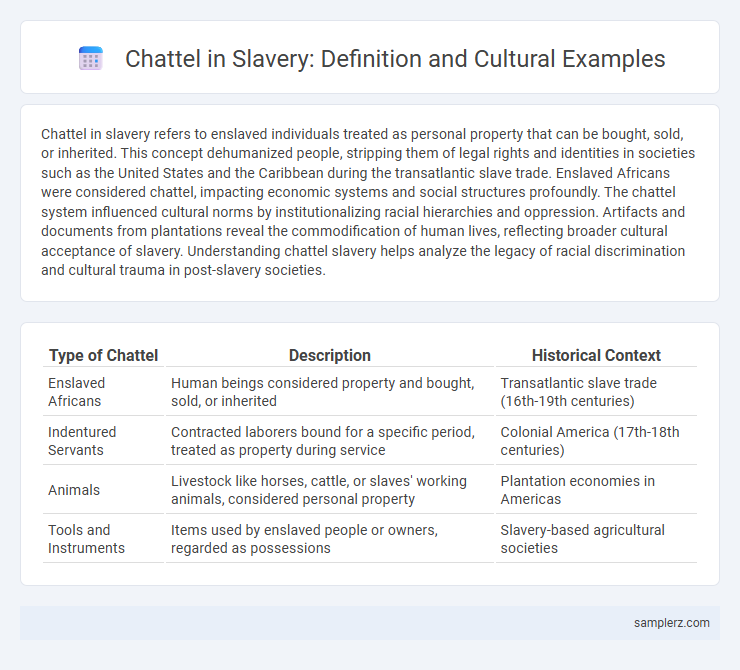Chattel in slavery refers to enslaved individuals treated as personal property that can be bought, sold, or inherited. This concept dehumanized people, stripping them of legal rights and identities in societies such as the United States and the Caribbean during the transatlantic slave trade. Enslaved Africans were considered chattel, impacting economic systems and social structures profoundly. The chattel system influenced cultural norms by institutionalizing racial hierarchies and oppression. Artifacts and documents from plantations reveal the commodification of human lives, reflecting broader cultural acceptance of slavery. Understanding chattel slavery helps analyze the legacy of racial discrimination and cultural trauma in post-slavery societies.
Table of Comparison
| Type of Chattel | Description | Historical Context |
|---|---|---|
| Enslaved Africans | Human beings considered property and bought, sold, or inherited | Transatlantic slave trade (16th-19th centuries) |
| Indentured Servants | Contracted laborers bound for a specific period, treated as property during service | Colonial America (17th-18th centuries) |
| Animals | Livestock like horses, cattle, or slaves' working animals, considered personal property | Plantation economies in Americas |
| Tools and Instruments | Items used by enslaved people or owners, regarded as possessions | Slavery-based agricultural societies |
Defining Chattel in the Context of Slavery
Chattel in the context of slavery refers to enslaved individuals who were legally treated as personal property, comparable to livestock or goods, with no personal autonomy or rights. This form of slavery reduced human beings to assets that could be bought, sold, inherited, or traded, fundamentally stripping away their humanity and legal identity. The chattel system underpinned economies in the Americas, particularly in plantation societies, reinforcing racial hierarchies through institutionalized dehumanization.
Historical Roots of Chattel Slavery
Chattel slavery, defined by the treatment of enslaved individuals as personal property to be bought, sold, and inherited, has deep historical roots tracing back to ancient civilizations such as Mesopotamia and Egypt. This system solidified during the transatlantic slave trade, where millions of Africans were forcibly transported and dehumanized to serve as lifelong laborers on plantations. The legacy of chattel slavery profoundly shaped social hierarchies and economic structures in the Americas, persisting in cultural memory and systemic inequalities.
Legal Status and Ownership of Enslaved Individuals
Chattel slavery classified enslaved individuals as personal property, granting owners absolute legal rights over their bodies, labor, and offspring. This dehumanizing status deprived enslaved people of personhood under the law, making them transferable assets in commerce and inheritance. Legal codes in colonies such as Virginia and Louisiana codified this ownership, reinforcing systemic control and exploitation.
Chattel Slavery in Transatlantic Slave Trade
Chattel slavery in the Transatlantic Slave Trade reduced enslaved Africans to property status, stripping them of all personal rights and legal personhood. Millions were forcibly transported across the Atlantic, branded, and sold as commodities to work primarily on plantations in the Americas. This system entrenched racial hierarchies and economic exploitation, deeply impacting cultural identities and social structures in both Africa and the New World.
Everyday Life Under Chattel Slavery
Chattel slavery reduced people to property, stripping enslaved Africans of autonomy and subjecting them to forced labor on plantations. Daily life under chattel slavery involved grueling work from dawn to dusk, minimal sustenance, and constant surveillance by overseers. Enslaved individuals were denied basic human rights, with families regularly separated and cultural practices suppressed to reinforce control and dehumanization.
Generational Impact of Chattel Status
Chattel slavery, where individuals were treated as property, imposed lasting generational trauma by legally binding children to the status of their enslaved parents. This hereditary condition perpetuated systemic inequalities and stripped entire families of autonomy, reinforcing cycles of poverty and social marginalization. The enduring legacy of chattel slavery continues to affect descendants, influencing cultural identity and access to resources across generations.
Economic Functions of Chattel Slavery
Chattel slavery served as a critical economic engine in plantation economies by providing a consistent and controlled labor force essential for large-scale cash crop production such as cotton, sugar, and tobacco. Enslaved individuals were considered property, enabling owners to use them as capital assets for credit, sale, and inheritance, thus fueling wealth accumulation and market expansion. This system entrenched social hierarchies and reinforced economic dependencies across colonial and antebellum societies worldwide.
Cultural Justifications for Chattel Slavery
Chattel slavery was culturally justified through deeply entrenched beliefs in racial hierarchy and dehumanization, portraying enslaved individuals as property rather than human beings. Religious narratives, including misinterpretations of biblical texts, were often manipulated to legitimize the ownership and exploitation of enslaved Africans. These cultural ideologies reinforced systemic oppression, embedding slavery into the social and economic fabric of societies for centuries.
Abolition Movements Challenging Chattel Practices
Chattel slavery, a system where individuals were treated as property, was vehemently opposed by prominent abolition movements such as the British Anti-Slavery Society and the American Abolitionist Movement. Activists like Frederick Douglass and William Wilberforce spearheaded efforts that highlighted the brutality of chattel practices, mobilizing international support for emancipation. Legislative milestones such as the British Slavery Abolition Act of 1833 and the U.S. Emancipation Proclamation of 1863 marked decisive victories against chattel slavery worldwide.
Lasting Legacies of Chattel Slavery in Modern Culture
Chattel slavery, exemplified by the transatlantic slave trade that forcibly uprooted millions of Africans, left enduring legacies in modern culture through systemic racial inequalities and cultural erasure. The commodification of human beings during this period deeply influenced contemporary social hierarchies and economic disparities, perpetuating stereotypes and marginalization in art, literature, and media. Modern cultural expressions often reflect and challenge these historical injustices, highlighting the ongoing impact of chattel slavery on identity and social dynamics.

example of chattel in slavery Infographic
 samplerz.com
samplerz.com